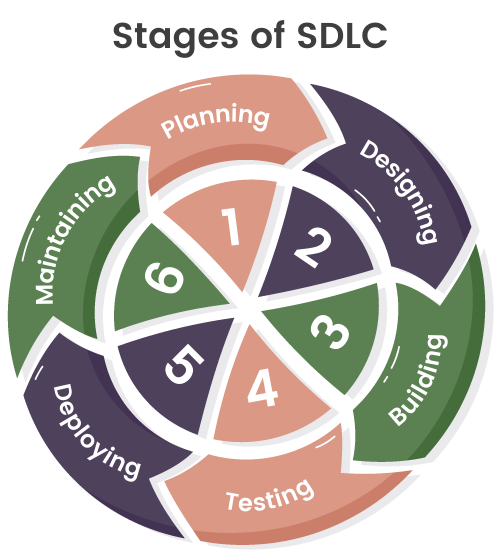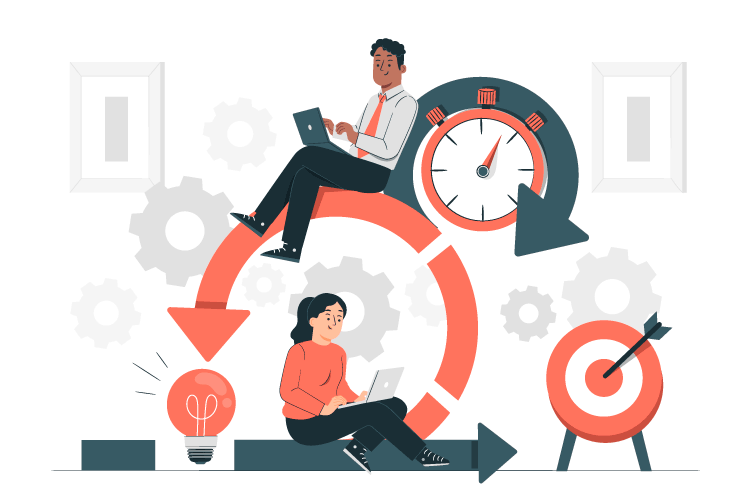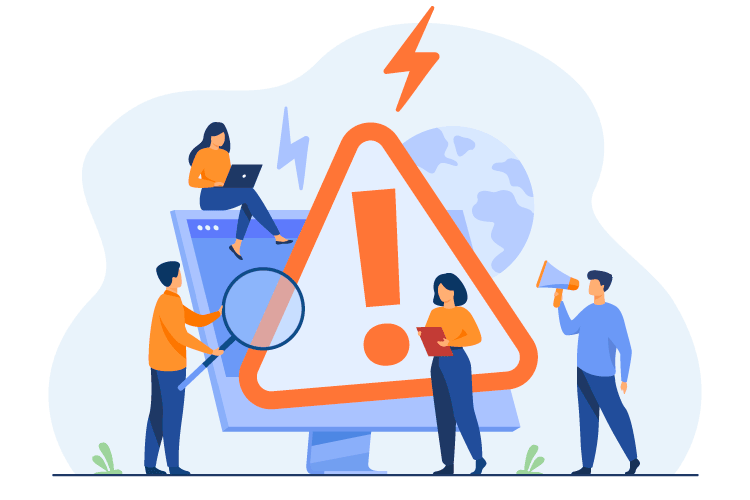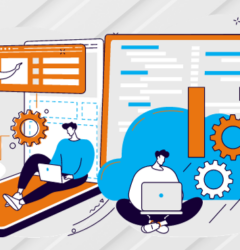
Since the advent of software, the world has become much more sophisticated in the last two decades. In the world of information technology, businesses and individuals are continually innovating and developing software and programs.
Any software solution’s success depends on its methodology and the quality of effort put into its development.
The software development process used to be ambiguous and inefficient, resulting in inconsistent and unpredictable results before software development models were introduced. Standards to reduce mismatches between product expectations and prototypes were achieved by using standard agile frameworks and models. SDLC Vs Agile has been the standard question; let’s dive deep into understanding these.
What is SDLC?
The Software Development Life Cycle is referred to as SDLC. The SDLC helps us deliver software with the highest quality at the lowest cost.
Using SDLC, an organization can develop software in a well-structured way and maintain quality by testing and validating user specifications before releasing the software to a live environment. SDLC offers a well-structured flow of different phases.
An application development life cycle is also known as the Software Development Life Cycle or SDLC, and it can be used to develop both hardware and software components.
Iterative and incremental processes are incorporated into the SDLC model. Ensuring quick delivery of a working software solution, it focuses more on customer satisfaction and process adaptability.
Phases of SDLC
SDLC consists of various phases.

1. Planning
The first step is to gather and analyze requirements. This process includes getting customer input, meeting senior managers, and learning about sales and marketing. The requirements should be properly documented. The document is referred to as the Software Requirements Specification (SRS). As part of the project life cycle, the product requirements are outlined.
2. Design
Using the output of the initial phase, the SRS document (Software Requirement Specification), we generate a software architecture for implementing system development.
In addition to identifying and specifying the system and hardware requirements, this phase also helps define the overall programming language framework, database architecture, and system architecture.
The system design specifications are used as input in the next phase of the model.
Also Read: 4 SDLC Pain Points of Traditional Development and solving them with No-Code
3. Implementation
A suitable programming language is used in the implementation of the project. Compilers, interpreters, code editors, integrated development environments, and debuggers can all be used to write and test programs. Depending on the application, the programming language can be chosen. During this phase, the developed module is tested unit by unit.
4. Testing
Testing ensures that a software program works as expected. This way, we can determine whether the final project meets the requirements. Testing includes integration testing, system testing, etc. Two modules are tested together during integration testing, and a system test is a complete project test.
5. Delivery/Deployment
Ultimately, the product is released in the market. A brand-new feature can be added to the product based on customer feedback. Existing customers receive maintenance and the required services. SDLC consists of these major phases.
6. Maintenance
Publishing the software does not end the process. You need to be checking, tracking and analyzing it on timely basis to ensure that you are extracting actual value out of it. The operation needs a lot of operational maintenance after launch.
Also Read: 4 SDLC Pain Points of Traditional Development and solving them with No-Code

What is Agile Methodology?
The Agile workflow model believes every project needs to be handled differently and existing methods must be tailored to suit the requirements properly. A release is divided into time boxes to deliver specific features.
An iterative approach is taken, and the working code is delivered after each iteration. Each build is incremental in terms of features; the final build holds all the features required by the customer.
As a result of its flexibility and adaptability, the Agile thought process became popular with time in software development.
Rational Unified Process (1994), Scrum (1995), Crystal Clear, Extreme Programming (1996), Adaptive Software Development, feature-driven development, and Dynamic Systems Development Method (DSDM) (1995) are some of the most popular Agile methodologies.

The Agile Manifesto has the following principles:
- Co-location and pair programming are key interactions in Agile development. Self-organization and motivation are also significant.
- Instead of just relying on documentation, demoing working software is considered one of the most effective ways to communicate with customers.
- Getting proper product requirements requires continuous customer interaction, as the requirements cannot be fully gathered at the beginning of the project due to various factors.
- Agile development emphasizes quick responses to change and continuous improvement.
Also Read: The Basics Of Agile Methodology And Agile Software Development
Phases Of Agile Methodology
Planning and Requirements Gathering
Similar to SDLC, Agile starts with understanding what needs to be built. However, instead of gathering all requirements upfront, Agile focuses on gathering just enough information to start work. This involves creating a prioritized list of features called the backlog.
Sprint Planning
Agile projects are divided into short iterations called sprints, typically lasting 1-4 weeks. Before each sprint, the team plans what tasks they will tackle from the backlog and how they will accomplish them.
Development
During the sprint, the team works on implementing the features they planned for. Unlike traditional methods where all development is done upfront, Agile encourages continuous development and delivery.
Daily Stand-ups
Every day, the team meets for a short stand-up meeting to discuss progress, any obstacles encountered, and plans for the day. This ensures everyone is on the same page and can quickly address any issues that arise.
Continuous Integration and Testing
As code is written, it’s continuously integrated into the main codebase and tested. This helps catch any bugs early on and ensures the software remains stable throughout development.
Review and Retrospective
At the end of each sprint, the team reviews the work done and demonstrates the completed features to stakeholders. They also hold a retrospective meeting to discuss what went well, what could be improved, and any changes needed for future sprints.
Incremental Delivery
Throughout the project, working software is delivered in increments at the end of each sprint. This allows for early feedback from stakeholders and the ability to adapt to changing requirements.
Continuous Improvement
Agile emphasizes continuous improvement, both in the product being developed and in the way the team works. Feedback from stakeholders and retrospectives is used to make adjustments and improvements in future sprints.
Completion and Deployment
Once all planned features are implemented and tested, the product is ready for deployment. This can happen at the end of a single sprint or after multiple sprints, depending on the project’s scope and timeline.
Ongoing Maintenance and Iteration
After deployment, the team continues to maintain and iterate on the product based on user feedback and changing requirements. This ensures the product remains valuable and relevant over time.
Core Difference between SDLC vs Agile methodologies
| Differences | SDLC | Agile |
|---|---|---|
| Methodology | An SDLC (Software Development Lifecycle) is a process used to manage a project efficiently. | A project management methodology based on an iterative approach is known as Agile. |
| Stages | During the development process, there are different stages. | The development model or methodology will have different phases. |
| Delivery | At the end of the SDLC life cycle, the entire project is delivered in one massive delivery. | Agile allows the project to be broken down into multiple small chunks at defined intervals. The MVP (Minimum Viable Product) is delivered at the end of each sprint. |
| Flexibility | Relies on a predetermined plan with limited room for adjustments once a phase starts. | Developers and the entire team will find it flexible. |
| Product Quality | To deliver good quality products efficiently, SDLC is known for its adequate processes and frameworks. | To incorporate and maintain the quality of software products, Agile uses an incremental development approach. |
| Project Size | Any size project can be completed with it. | Particularly suitable for smaller projects. |
| Approach | For software development, the SDLC model uses a predictive approach. | The agile methodology is based on an adaptive approach to software development. |
| Platform | The platform supports the development of any product or software application. | Splitting it into incremental builds can support any product. |
| Release | The SDLC provides a single cycle and a single release process. | In Agile, iterations and multiple releases are repeated repeatedly. |
| Usage | Using it, quality products can be created efficiently. | This approach is used as an incremental development approach to produce a quality software product. |
| Customer Interaction | One of the biggest disadvantages of SDLC is the long distance between the customer and the developer. | Software products are produced incrementally using this approach. |
Benefits of SDLC
Process-oriented
SDLC defines a structured approach to software development, often using predetermined phases like planning, design, development, testing, and deployment.
Rigorous documentation
Each phase typically involves detailed documentation, ensuring clear communication and traceability throughout the project lifecycle.
Predictability
SDLC aims for well-defined requirements upfront, leading to a more predictable development process and timeline.
Less flexible
Due to its structured nature, adapting to significant requirement changes mid-project can be challenging in SDLC methodologies.
Also Read: Building Software Faster and Better with Hyper Agile SDLC and Citizen Development
Limitations of the SDLC Model
The following are the main points of the SDLC model–
- This is not the ideal model for a large, complex, and ongoing project.
- It is less effective if the requirement is unclear at the beginning.
- Making changes in the previous phases is very difficult.
- Once development is complete, testing begins. Therefore, it is likely to discover bugs later in development, which will be costly to fix.
- Even during the development phase, this model does not offer much scope for change.
- Even during the development phase, this model does not offer much scope for change.
- Testing is often delayed until completion, making large revisions more expensive.
- We are at high risk of uncertainty and risk due to unnoticed issues until the project is in its final phase.

Benefits of Agile
The following are the benefits of using Agile development method.
Iterative and incremental
Agile breaks down development into short, iterative cycles called sprints. Each sprint focuses on delivering a specific set of features with continuous feedback and adaptation.
Flexibility
Agile prioritizes adaptability to changing requirements. New features or changes can be incorporated throughout the development process.
Faster feedback
Agile promotes frequent communication and collaboration between stakeholders, leading to faster feedback loops and course correction.
Reduced documentation
While documentation is still important, Agile emphasizes working software over extensive documentation.
Also Read: Citizen Development Can Pave the Way For Agility. Here’s how
Limitations of the Agile Model
Following are the limitations of Agile model.
- This method cannot handle complex dependencies.
- There is a substantial risk of sustainability, maintainability, and extensibility.
- It needs an overall plan, an agile leader, and an agile PM practice to succeed.
- A strict delivery management process determines the scope, functionality, and adjustments to be made to meet deadlines.
- The team can be driven in the wrong direction when the customer is unclear.
- Due to the lack of documentation, there is a very high level of individual dependency.
- The lack of documentation may make it difficult to transfer technology to new team members.
Also Read: 6 Signs that your Legacy System is an obstacle for your business’s Digital Transformation!
Choosing the Right Software Development Approach: SDLC vs Agile
Project Complexity and Size
- SDLC: Best for large, complex projects with clear requirements.
- Agile: Ideal for projects of varying sizes with evolving requirements.
Customer Involvement and Feedback
- SDLC: Suited for fixed customer requirements.
- Agile: Emphasizes continuous customer collaboration and flexibility.
Project Flexibility
- SDLC: Rigid and sequential, less suitable for ongoing adjustments.
- Agile: Allows ongoing adjustments for flexibility.
Team Size and Expertise
- SDLC: Works well with large, specialized teams.
- Agile: Effective with smaller, cross-functional teams.
Project Timeline
- SDLC: Tends to have longer timelines.
- Agile: Promotes quicker deliverables with shorter iterations.
Risk Tolerance
- SDLC: Mitigates risks upfront, suited for low change tolerance.
- Agile: Embraces change, suited for higher risk tolerance.
Regulatory Compliance
- SDLC: Emphasizes documentation for strict compliance.
- Agile: Can meet regulatory requirements with additional documentation.
Previous Experience
- Consider your team’s familiarity with both methodologies.
Hybrid Approaches
- Consider combining elements of both SDLC and Agile for specific project needs.
Ultimately, the choice between SDLC and Agile should align with your project’s unique circumstances and requirements. You may also consult with stakeholders, project managers, and team members to make an informed decision. In some cases, a pilot project using one approach can help you determine if it’s the right fit before committing to it for larger endeavors.
Quixy: Your Agile Development Ally in the Race for Innovation
The dynamic nature of Agile development necessitates a flexible and collaborative approach. However, traditional coding methods can often become a bottleneck, hindering agility and team efficiency. Quixy’s no-code low-code platform emerges as a powerful ally in this scenario, fostering a relaxed IT environment and empowering business-led innovation.
By enabling citizen developers through drag-and-drop functionalities and pre-built components, Quixy empowers them to build prototypes and internal tools rapidly. This frees up valuable IT resources, allowing them to focus on core functionalities and complex technical challenges. Moreover, Quixy facilitates continuous iteration by simplifying application modifications. New features based on user feedback can be incorporated quickly, ensuring projects remain aligned with evolving business needs.
Quixy fosters a transparent and collaborative environment that aligns perfectly with business-led IT principles. The platform provides a centralized hub for managing the entire development process, offering clear workflow visualizations, progress tracking, and seamless team collaboration – all within a single, intuitive interface. This transparency empowers the business to have a clear view of the backlog and prioritize tasks effectively, ultimately reducing the backlog and fostering innovation.
Conclusion
Agile is a methodology, whereas SDLC is a process. SDLC has different methods within it, and Agile is one of them. In the SDLC, there are various methodologies, such as Agile, Waterfall, Unified Model, V Model, and Spiral Model. The selection of the methodology of traditional SDLC vs Agile depends on the understanding of digital transformation needs and size of the project. The same approach can also be applied to the STLC, called the Software Testing Life Cycle.
Frequently Asked Questions(FAQs)
Q. What is the difference between SDLC and Agile?
SDLC follows a sequential and structured approach to software development, while Agile is an iterative and flexible methodology that emphasizes collaboration and adaptability.
Q. How do SDLC & Agile handle changes during development?
SDLC finds it challenging to accommodate changes once development has started, while Agile embraces changes throughout the project, allowing for adjustments based on feedback and evolving requirements.
Q. How does approach to planning differ between SDLC & Agile?
SDLC involves detailed upfront planning, including requirements and designs, before development starts. Agile focuses on adaptive planning, with high-level requirements set at the beginning and detailed planning done incrementally before each iteration.
Q. What is the role of customer involvement in SDLC and Agile?
SDLC involves customer interaction primarily at the beginning and the end of the project. Agile encourages continuous customer collaboration throughout development, ensuring their needs are met and changes are incorporated.
Q. Which methodology is better for projects with changing requirements?
Agile is better suited for projects with changing requirements due to its flexible nature and adaptive planning, allowing for regular adjustments and frequent feedback incorporation.
Login
Please login to comment
0 Comments
Oldest
















